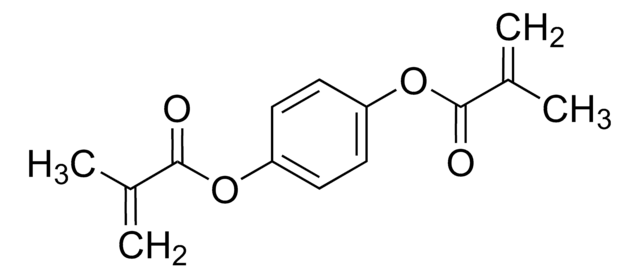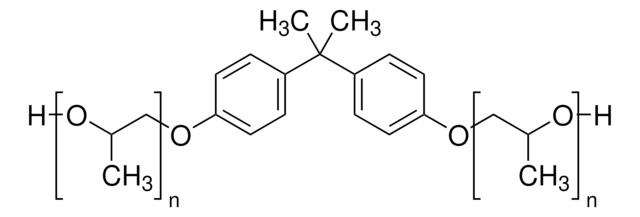411167
Bisphenol A glycerolate (1 glycerol/phenol) diacrylate
contains MEHQ as inhibitor
Sinónimos:
2,2-Bis[4-(3-acryloyloxy-2-hydroxypropoxy)phenyl]propane, 2,2-Bis[acryloyloxy(2′-hydroxypropyloxy)phenyl]propane, Bisphenol A glycerolate diacrylate
About This Item
Productos recomendados
contiene
MEHQ as inhibitor
250-500 ppm MEHQ as inhibitor
índice de refracción
n20/D 1.557 (lit.)
viscosidad
2000-4000 cP(65 °C)(lit.)
número de ácido
<5 mg KOH/g
densidad
1.18 g/mL at 25 °C (lit.)
cadena SMILES
CC(C)(c1ccc(OCC(O)COC(=O)C=C)cc1)c2ccc(OCC(O)COC(=O)C=C)cc2
InChI
1S/C27H32O8/c1-5-25(30)34-17-21(28)15-32-23-11-7-19(8-12-23)27(3,4)20-9-13-24(14-10-20)33-16-22(29)18-35-26(31)6-2/h5-14,21-22,28-29H,1-2,15-18H2,3-4H3
Clave InChI
VZTQQYMRXDUHDO-UHFFFAOYSA-N
Categorías relacionadas
Aplicación
Características y beneficios
Forma física
Palabra de señalización
Warning
Frases de peligro
Consejos de prudencia
Clasificaciones de peligro
Skin Sens. 1
Código de clase de almacenamiento
10 - Combustible liquids
Clase de riesgo para el agua (WGK)
WGK 3
Punto de inflamabilidad (°F)
235.4 °F - closed cup
Punto de inflamabilidad (°C)
113 °C - closed cup
Equipo de protección personal
Eyeshields, Faceshields, Gloves, type ABEK (EN14387) respirator filter
Elija entre una de las versiones más recientes:
¿Ya tiene este producto?
Encuentre la documentación para los productos que ha comprado recientemente en la Biblioteca de documentos.
Los clientes también vieron
Nuestro equipo de científicos tiene experiencia en todas las áreas de investigación: Ciencias de la vida, Ciencia de los materiales, Síntesis química, Cromatografía, Analítica y muchas otras.
Póngase en contacto con el Servicio técnico











